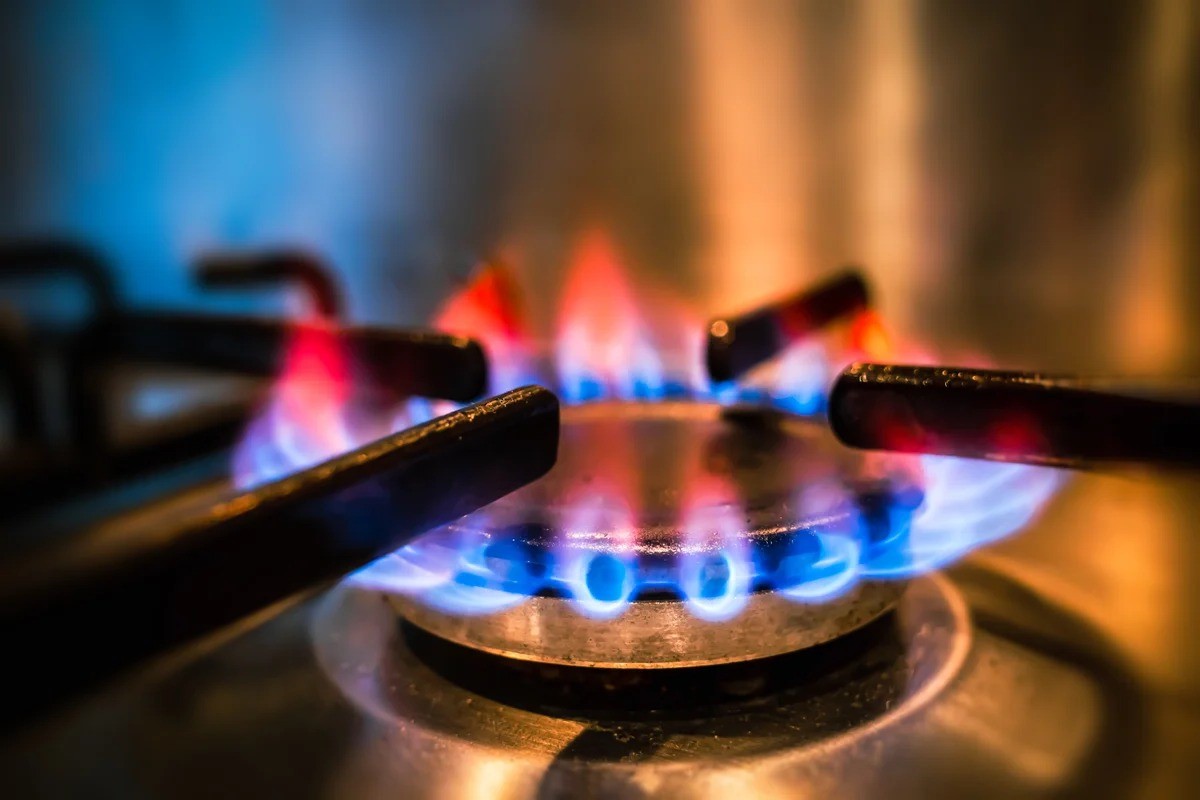Home>Food and Cooking>How To Use A Gas Stove


Food and Cooking
How To Use A Gas Stove
Published: February 27, 2024
Learn how to safely and efficiently use a gas stove for food and cooking. Discover tips and techniques for mastering this essential kitchen appliance.
(Many of the links in this article redirect to a specific reviewed product. Your purchase of these products through affiliate links helps to generate commission for Noodls.com, at no extra cost. Learn more)
Table of Contents
Introduction
A gas stove is a versatile and efficient cooking appliance that has been a staple in kitchens around the world for decades. Its popularity stems from its ability to provide instant and consistent heat, making it an essential tool for preparing a wide variety of dishes. Whether you're a seasoned home cook or just starting to explore the culinary world, understanding how to use a gas stove effectively can significantly enhance your cooking experience.
Gas stoves are favored for their precise temperature control, allowing cooks to quickly adjust the heat levels to achieve the perfect simmer, boil, or sauté. Unlike electric stoves, which rely on heating elements that take time to warm up and cool down, gas stoves offer immediate responsiveness, giving you more control over the cooking process.
In addition to their performance benefits, gas stoves are also valued for their reliability during power outages. Since they operate independently of electricity, you can continue cooking even when the power grid is down, making them a practical choice for households in areas prone to outages.
Furthermore, the visual cues provided by the flames of a gas stove can be a source of inspiration for many cooks. Observing the dance of the flames as they envelop the cookware can evoke a sense of connection to the cooking process, adding a touch of romance to the culinary experience.
In this comprehensive guide, we will delve into the various aspects of using a gas stove, from essential safety precautions to mastering the art of adjusting the flame for optimal cooking results. Whether you're a newcomer to gas stoves or looking to refine your skills, this guide will equip you with the knowledge and confidence to make the most of this classic cooking appliance. So, let's embark on this culinary journey and unlock the full potential of your gas stove!
Safety Precautions
When using a gas stove, prioritizing safety is paramount to ensure a secure and enjoyable cooking experience. By adhering to essential safety precautions, you can minimize the risk of accidents and create a secure environment in your kitchen. Here are some crucial safety measures to keep in mind:
-
Ventilation: Adequate ventilation is crucial when using a gas stove. Ensure that your kitchen is well-ventilated to prevent the accumulation of gas fumes. If your kitchen lacks proper ventilation, consider using a range hood or opening windows to allow fresh air to circulate.
-
Gas Leaks: Regularly inspect the gas connections and hoses for any signs of wear or damage. If you detect the smell of gas, immediately turn off the stove, open windows, and refrain from using any open flames. Contact a professional to address the issue and avoid using the stove until it has been deemed safe.
-
Flammable Materials: Keep flammable materials, such as kitchen towels, curtains, and paper towels, away from the stove while cooking. This precaution helps prevent accidental fires and ensures a safe cooking environment.
-
Child Safety: If you have young children in the household, install stove knob covers to prevent them from accidentally turning on the gas burners. Additionally, educate children about the potential hazards of the stove and the importance of seeking adult assistance when using it.
-
Unattended Cooking: Never leave the gas stove unattended while it is in use. Unattended cooking can lead to hazardous situations, including overflows, spills, or uncontrolled flames. Stay vigilant and attentive when the stove is operational.
-
Cleanliness: Regularly clean the stove and its components to prevent the accumulation of grease and food debris, which can pose fire hazards. Additionally, ensure that the burner ports are free from blockages to maintain optimal gas flow and combustion.
By conscientiously observing these safety precautions, you can create a secure cooking environment and enjoy the benefits of using a gas stove without compromising on safety. Prioritizing safety not only safeguards you and your loved ones but also contributes to a more enjoyable and stress-free cooking experience.
Lighting the Gas Stove
Lighting a gas stove is a fundamental yet crucial step in the cooking process. Whether you're preparing a quick breakfast or simmering a savory stew, knowing how to safely and effectively ignite the gas burners is essential. Here's a step-by-step guide to lighting a gas stove:
-
Check for Gas Odor: Before lighting the stove, take a moment to sniff for any unusual gas odors. If you detect the distinct smell of gas, do not proceed with lighting the stove. Instead, ventilate the area by opening windows and refrain from using any open flames. Contact a professional to address the issue promptly.
-
Clear the Burner Area: Ensure that the burner area is free from any obstructions, spills, or debris. Clearing the burner grates and surrounding area of any potential obstacles minimizes the risk of accidental fires and ensures a safe lighting process.
-
Turn Off Knobs: Confirm that all stove knobs are in the "off" position before attempting to light the burners. This precaution prevents gas from flowing unchecked and reduces the risk of unexpected ignition.
-
Select the Burner: If your gas stove has multiple burners, choose the specific burner you intend to light. This selection ensures that you direct your focus and attention to the designated burner, minimizing the likelihood of errors.
-
Ignition Method: Depending on your stove model, you can use either a built-in ignition system or a manual ignition method. For stoves equipped with an automatic ignition feature, simply turn the corresponding knob to the "light" position, and the burner will ignite automatically. If your stove requires manual ignition, use a long-reach lighter or match to carefully ignite the gas as you turn the knob to the "light" position.
-
Observe the Flame: Once the burner is lit, observe the flame to ensure that it is burning steadily and evenly. A consistent blue flame indicates proper combustion and efficient heat production. If the flame appears yellow or exhibits irregular patterns, it may signify an issue with the gas-air mixture or burner cleanliness, requiring further attention.
-
Adjust the Flame: After successfully lighting the burner, you can adjust the flame to your desired intensity using the corresponding knob. Whether you need a gentle simmer or a vigorous boil, the ability to fine-tune the flame allows for precise temperature control during cooking.
By following these steps, you can confidently and safely light your gas stove, setting the stage for a seamless and enjoyable cooking experience. Mastering the art of lighting the gas stove is a foundational skill that empowers you to embark on culinary adventures with confidence and precision.
Adjusting the Flame
Adjusting the flame on a gas stove is a pivotal aspect of harnessing its full culinary potential. Whether you're aiming for a gentle simmer, a rapid boil, or precise heat control for delicate cooking techniques, the ability to fine-tune the flame intensity empowers you to achieve optimal cooking results. Here's a detailed exploration of the art of adjusting the flame on a gas stove:
Understanding Flame Characteristics
Before delving into flame adjustment, it's essential to grasp the visual cues that indicate different flame characteristics. A well-adjusted gas flame typically exhibits a steady, blue color, signifying efficient combustion. A consistent blue flame indicates that the gas is burning cleanly and producing the desired heat output. On the other hand, a yellow or flickering flame may indicate incomplete combustion, potentially leading to uneven heating and soot accumulation on cookware.
Simmering and Boiling
When aiming for a gentle simmer, such as when preparing delicate sauces or slowly braising meats, adjusting the flame to a low setting is crucial. By reducing the flame to a minimal level, you can maintain a low, steady heat that prevents rapid boiling and allows flavors to meld gradually. Conversely, when you need to bring liquids to a rapid boil for pasta, blanching vegetables, or preparing stocks, increasing the flame to a higher setting expedites the heating process, achieving the desired boiling point efficiently.
Precision Cooking
For precision cooking techniques that demand specific temperature control, such as searing meats or sautéing delicate ingredients, the ability to finely adjust the flame intensity is invaluable. By making subtle adjustments to the flame, you can modulate the heat output to suit the requirements of the dish, ensuring that ingredients are cooked to perfection without scorching or undercooking.
Safety Considerations
While adjusting the flame, it's important to prioritize safety by ensuring that the burner area is free from any flammable materials or obstructions. Additionally, always use caution when handling the knobs to prevent accidental ignition or gas leaks. By maintaining a clear and safe cooking environment, you can confidently focus on adjusting the flame to achieve the desired cooking results.
Maintenance and Optimization
Regular maintenance of the gas stove, including cleaning the burner ports and ensuring proper gas flow, is essential for optimizing flame adjustment. Over time, burner ports may become clogged with debris, affecting the flame characteristics and heat distribution. By keeping the stove components clean and well-maintained, you can ensure that the flame adjustment mechanisms function optimally, allowing for precise and consistent heat control.
Mastering the art of adjusting the flame on a gas stove elevates your culinary prowess, enabling you to execute a diverse range of recipes with finesse and precision. By honing this fundamental skill, you can harness the full potential of your gas stove and embark on culinary adventures with confidence and creativity.
Read more: How To Operate A Gas Fireplace
Cooking on a Gas Stove
Cooking on a gas stove offers a myriad of culinary possibilities, allowing you to explore diverse cooking techniques and create an array of delectable dishes. The immediate and precise heat control provided by gas stoves empowers you to execute a wide range of recipes with finesse and efficiency. Whether you're searing meats, sautéing vegetables, or simmering sauces, understanding the nuances of cooking on a gas stove can elevate your culinary endeavors to new heights.
Searing and Sautéing
When it comes to achieving a perfect sear on meats or imparting a delightful caramelization to vegetables, the intense and immediate heat of a gas stove is invaluable. By preheating the pan over a high flame, you can swiftly achieve the ideal searing temperature, creating a flavorful crust on meats while locking in juices. Similarly, for sautéing vegetables, the ability to quickly adjust the flame intensity enables you to maintain precise heat control, ensuring that the vegetables are cooked to a tender yet crisp perfection.
Simmering and Braising
Gas stoves excel in facilitating gentle simmering and braising, allowing you to coax out complex flavors and tenderize ingredients with ease. The low, consistent heat produced by a gas stove's simmer burner is ideal for slowly braising meats or simmering sauces, infusing them with rich, nuanced flavors. Whether you're preparing a hearty stew or a delicate reduction, the reliable heat output of a gas stove provides the foundation for achieving exceptional depth of flavor in your culinary creations.
Boiling and Blanching
For tasks that require bringing liquids to a rapid boil, such as cooking pasta or blanching vegetables, the immediate responsiveness of a gas stove is indispensable. By adjusting the flame to a high setting, you can swiftly reach the desired boiling point, expediting the cooking process without unnecessary delays. The ability to modulate the flame intensity ensures that you can maintain a vigorous boil for efficient cooking while preventing the risk of overflowing or scorching.
Read more: How To Light A Gas Fireplace
Delicate Cooking Techniques
Gas stoves are well-suited for delicate cooking techniques that demand precise temperature control, such as melting chocolate, preparing custards, or executing intricate sauces. The nuanced flame adjustment capabilities enable you to fine-tune the heat output, ensuring that delicate ingredients are gently and evenly cooked without the risk of scorching or curdling. This level of control empowers you to execute intricate recipes with confidence and precision, expanding your culinary repertoire.
Versatility and Creativity
The versatility of a gas stove encourages culinary experimentation and creativity, allowing you to explore a diverse range of cooking styles and cuisines. Whether you're charring vegetables directly over the open flame, toasting spices for aromatic blends, or executing elaborate multi-step recipes, the responsive and adaptable nature of a gas stove provides a solid foundation for culinary innovation.
By harnessing the capabilities of a gas stove and understanding its nuances, you can embark on a culinary journey filled with exploration, creativity, and the joy of creating exceptional dishes. The seamless integration of heat control, responsiveness, and reliability offered by gas stoves empowers you to unleash your culinary creativity and elevate your cooking to new heights.
Cleaning and Maintenance
Proper cleaning and maintenance are essential for ensuring the longevity, safety, and optimal performance of a gas stove. By incorporating regular cleaning and maintenance practices into your kitchen routine, you can uphold a clean and functional cooking environment while extending the lifespan of your appliance.
Cleaning the Burners and Grates
Begin the cleaning process by removing the burner grates and caps from the stove. Soak them in a solution of warm, soapy water to loosen and remove accumulated grease, food residue, and stains. Use a non-abrasive brush or sponge to gently scrub the grates and caps, ensuring thorough cleaning without causing damage to the surfaces. Rinse them thoroughly and allow them to dry completely before reassembling them on the stove.
Read more: How To Turn On Gas Fireplace
Clearing Burner Ports
Over time, the burner ports of a gas stove may become clogged with debris, hindering the flow of gas and affecting the flame characteristics. To address this, use a small, soft-bristled brush or compressed air to clear any obstructions from the burner ports. Ensuring that the ports are free from blockages promotes optimal gas flow and combustion, contributing to consistent flame performance.
Surface Cleaning
Wipe down the surface of the stove with a mild, non-abrasive cleaner to remove grease, spills, and stains. Pay attention to the control knobs, ensuring that they are free from residue and operate smoothly. Additionally, clean the area around the burners and the stove's exterior to maintain a tidy and hygienic cooking space.
Oven Cleaning (if applicable)
If your gas stove includes an oven, regular cleaning of the oven interior is essential for maintaining a sanitary and odor-free cooking environment. Follow the manufacturer's guidelines for oven cleaning, which may involve using specialized oven cleaners or natural cleaning solutions to remove baked-on food particles and grease.
Checking Gas Connections
Periodically inspect the gas connections, hoses, and fittings for any signs of wear, damage, or leaks. If you detect the smell of gas or notice hissing sounds near the connections, immediately turn off the gas supply and seek professional assistance to address the issue. Ensuring the integrity of the gas connections is crucial for preventing potential hazards and maintaining a safe cooking environment.
Routine Maintenance
In addition to regular cleaning, consider scheduling routine maintenance checks by a qualified technician to assess the overall condition of the gas stove. Professional maintenance can involve inspecting the ignition system, verifying gas flow, and addressing any potential issues that may affect the stove's performance. By proactively addressing maintenance needs, you can mitigate the risk of unexpected malfunctions and ensure the continued reliability of your gas stove.
By incorporating these cleaning and maintenance practices into your kitchen routine, you can uphold a clean, safe, and efficient cooking environment while prolonging the lifespan of your gas stove. Prioritizing regular maintenance and attentive cleaning not only enhances the performance of the appliance but also contributes to a pleasant and stress-free cooking experience.
Conclusion
In conclusion, mastering the art of using a gas stove is a journey that intertwines practicality, creativity, and culinary finesse. From the foundational steps of lighting the stove to the nuanced skill of adjusting the flame, each aspect contributes to a seamless and rewarding cooking experience. The safety precautions underscore the importance of creating a secure cooking environment, ensuring that the joy of cooking is accompanied by peace of mind.
Cooking on a gas stove transcends mere culinary functionality, offering a canvas for culinary exploration and innovation. The immediate heat control, versatility, and reliability of gas stoves empower cooks to experiment with diverse cooking techniques, from searing and sautéing to simmering and precision cooking. The visual cues provided by the dancing flames evoke a sense of connection to the cooking process, infusing each culinary endeavor with a touch of artistry and inspiration.
Moreover, the significance of regular cleaning and maintenance cannot be overstated. By upholding a clean and well-maintained gas stove, cooks can ensure the appliance's longevity, safety, and optimal performance. The meticulous care invested in cleaning the burners, clearing the ports, and inspecting gas connections contributes to a hygienic and secure cooking environment, fostering a seamless and enjoyable culinary journey.
Ultimately, the gas stove stands as a timeless culinary companion, offering a harmonious blend of tradition and innovation. Its ability to deliver immediate heat, precise control, and reliability makes it an indispensable tool for both seasoned cooks and culinary enthusiasts embarking on their cooking adventures. By embracing the art of using a gas stove, individuals can unlock a world of culinary possibilities, infuse their creations with passion and precision, and savor the joy of bringing delightful dishes to life.
In essence, the gas stove transcends its utilitarian function, embodying a source of inspiration, creativity, and culinary mastery. As the flames dance and the aromas of delectable dishes fill the air, the gas stove becomes a conduit for culinary expression, inviting cooks to embark on a journey of exploration, innovation, and the sheer delight of creating exceptional meals.










